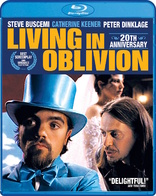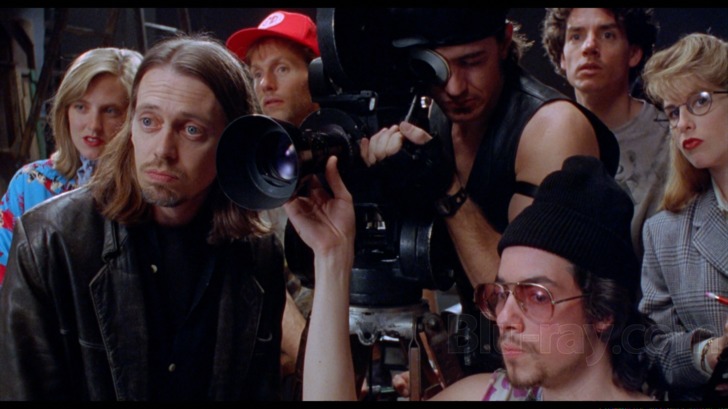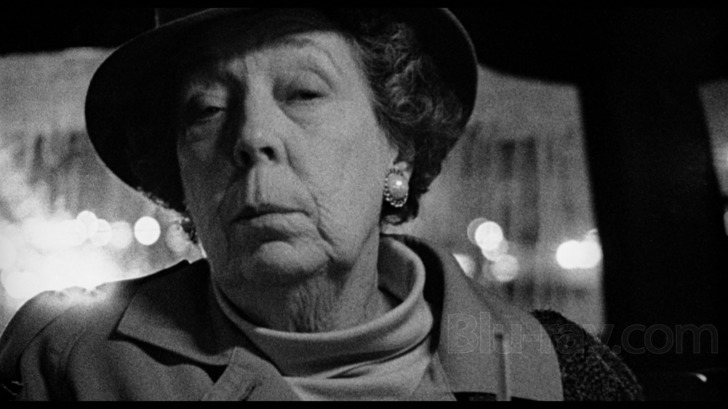Living in Oblivion Blu-ray Movie
HomeLiving in Oblivion Blu-ray Movie 
Blu-ray + DVDShout Factory | 1995 | 90 min | Rated R | Nov 17, 2015

Movie rating
7.2 | / 10 |
Blu-ray rating
| Users | 4.0 | |
| Reviewer | 4.0 | |
| Overall | 4.0 |
Overview
Living in Oblivion (1995)
A shrewdly funny film. The story follows a disaster-filled day in the life of a director as he desperately tries to fulfill his vision and shoot his movie despite whining actors, bumbling crew members, exploding lights and malfunctioning fog machines.
Starring: Steve Buscemi, Catherine Keener, Dermot Mulroney, Danielle von Zerneck, James Le GrosDirector: Tom DiCillo
| Drama | Uncertain |
| Comedy | Uncertain |
Specifications
Video
Video codec: MPEG-4 AVC
Video resolution: 1080p
Aspect ratio: 1.85:1
Original aspect ratio: 1.85:1
Audio
English: DTS-HD Master Audio 2.0
Subtitles
English
Discs
50GB Blu-ray Disc
Two-disc set (1 BD, 1 DVD)
DVD copy
Playback
Region A (C untested)
Review
Rating summary
| Movie | 4.0 | |
| Video | 3.5 | |
| Audio | 4.0 | |
| Extras | 3.0 | |
| Overall | 4.0 |
Living in Oblivion Blu-ray Movie Review
Close, but cigar?
Reviewed by Jeffrey Kauffman December 6, 2015Whether or not Sigmund Freud actually said “Sometimes a cigar is just a cigar” (or words to that effect) is still being hotly debated in various corners of the internet if not in actual scholarly circles, but the underlying truth of the statement can probably find no more salient example than the reaction that Lindsay Anderson’s If.... engendered when it was first released in 1968 (and even beyond). The fact that Anderson and cinematographer Miroslav Ondricek shot the movie on both black and white and color stock caused all sorts of critical exegesis, much of which tried to tie these different sequences with the film’s concurrent mixing of fantasy and reality. Whole edifices of critical assessment were built upon the sometimes odd juxtapositions of black and white and color segments, with some analysts tying themselves into mounds of pretzel logic in order to try to make sense of whatever their hypotheses were supposed to be. This attempt to find meaning or at least symbolism in something, in other words to make a cigar something else, is a peculiar human endeavor, and it is sometimes such a strong impetus that more mundane explanations can be overlooked in the rush to achieve some kind of cathartic philosophical breakthrough. And so the punchline to this particular example turned out to be the fact that various people involved in If. . .’s production, including Anderson and star Malcolm McDowell, have gone on record stating there was really no “meta” aspect to the crazy quilt approach toward the film’s palette, but instead one that was largely based on economics or at least the economy of lighting and shooting some scenes monochromatically rather than in color. In other words, there was no “reason” for these choices other than the basic necessities of getting stuff committed to celluloid under sometimes trying circumstances. Some similarly prone critics may approach Living in Oblivion with a similar urge to “make it all make sense”, especially since this film not only traffics in the same black and white versus color ambiences that informed If. . ., but ups the ante in a way by having the first of the film’s three sections shot on 16mm, with the last two in the more traditional 35mm format. Add to that the fact that Living in Oblivion actually luxuriates in certain “meta” aspects, including the fact that the film deals with filmmakers making a film called Living in Oblivion (got that?), and it’s certainly understandable why some might go into veritable hyperdrive trying to explain it all. In this case, however, to maybe cop a concept from a certain feline attached to a certain Schrödinger, sometimes a cigar both is just and is not just a cigar.

Anyone who has experienced the “glamour” of show business from the inside, no matter which of the performing arts is involved, will probably tell you the illusion of glitz and nonstop wonderfulness is, well, an illusion. The hard nosed reality of what it’s like to be on a film shoot, and specfically a shoot for a low budget independent film, is capably documented in the early moments of Living in Oblivion as a craft services table may have offerings that are well past their expiration date (a seemingly odd setup for what turns out to be a horrifyingly funny punchline down the road). While the crew debates the edibility and/or potability of various foodstuffs in the predawn murk, two actors are on their way to the set, ingenue Nicole (Catherine Keener) and elderly Cora (Rica Martens), who are playing daughter and mother in the film.
Director Nick Reve (Steve Buscemi, wonderfully addled throughout the film) is on hand attempting to wrangle a ragtag bunch of crew members, but also trying to achieve a modicum of emotional honesty in the scene he wants to shoot, a deceptively simple sequence involving the character Nicole is playing berating the character Cora is playing for not having protected her as a child from an overbearing and violent father. Nicole is nervous about the scene, as she has already confessed to the morning’s driver, but she seems to literally have her act together as the first take is undertaken, only to have it spoiled by a technical snafu, something that will repeatedly (as in repeatedly) happen, driving Reve to near apoplexy.
Writer-director Tom DiCillo, who repeatedly talks about the dissatisfaction with the film industry which sparked Living in Oblivion, seemingly delights in showing how interlinked and thus dependent a film crew is on each other, something that means if one person makes a mistake, everyone suffers. A cascading series of screw ups seems to be putting the entire shoot in jeopardy as the first third of the film comes to a close with the startling revelation that—it’s all been a dream of Reve’s, who is in fact only about to start shooting the film.
That sets Living in Oblivion off on its second section, where some of the personal stories of various cast and crew members begin to play into the proceedings. Nicole has had at least a one night stand with her leading man, the wonderfully named Chad Palomino (James LeGros), but their continued relationship is a bit more tenuous. That tension ends up playing out on set, as Chad, a rather self involved actor, decides to go all Method on everyone, once again driving the assembled multitudes to distraction. Things devolve quickly through a series of farcical misunderstandings, leading to the startling revelation that—it’s all been a dream of Nicole’s, who is in fact only about to start shooting the film.
Twin Peaks: The Entire Mystery was still a relatively recent phenomenon when Living in Oblivion appeared in 1995, and some may feel that the film’s third section is a none too subtle dig at some of the Lynchian hyperbole that informed the short lived but epochal television series, especially with regard to a certain repeated fantasy element that became one of the show's "signature hallucinations." In this case, Reve is attempting to film a bizarre dream sequence which features Nicole as a bride having a rather, well, unusual interaction with a dwarf named Tito (a hilariously ornery Peter Dinklage). Things continue to go spectacularly wrong for Reve and the crew, but Living in Oblivion’s rather sweet, optimistic conclusion seems to be that the show must indeed go on.
Despite the fact that DiCillo ended up hiring a retinue of non-professionals for supporting roles, many of whom got their parts by contributing funding to the project, there’s less of a “not ready for prime time” feeling about Living in Oblivion than might be expected. Both Buscemi and LeGros are surprisingly facile in comedic guises, and Keener manages to capture a hint of actual humanity, providing a kind of naturalistic core around which much of the other insanity unfolds. The film’s convoluted structure may seem “meaningful”, but it was really less the product of design than the result of various vagaries of chance. DiCillo only managed to put together enough scratch to make what he initially envisioned as a short, which is one reason why the first section of the film was shot on 16mm. When that first section was completed, he realized it was too long to be a traditional short, but too short to be a traditional feature, and so he went back to the drawing board, utilizing what was already completed as a foundation on which to build the two subsequent sequences. The result is actually surprisingly organic feeling, all things considered, with DiCillo often offering playful stylistic touches along the way (the first sequence offers the “real life” moments in black and white and the film within a film moments in color, while later sequences reverse that approach).
Living in Oblivion Blu-ray Movie, Video Quality 

Living in Oblivion is presented on Blu-ray courtesy of Shout! Factory with an AVC encoded 1080p transfer in 1.85:1. With an understanding about the aforementioned differences in format, this presentation is quite organic and natural looking, with the first sequence looking understandably softer and grainier than the second two. The black and white sequences of the first part of the film have decent if not overwhelming contrast, though black levels are largely commendable. The color is quite nicely suffused in the 16mm sequences. The bulk of the 35mm material looks decently detailed if again quite often on the soft side. Grain resolves naturally most of the time, though there are typical Shout! bugaboos with splotchiness occasionally entering the fray. Elements have a few minor instances of damage along the way, including speckling and white flecks.
Living in Oblivion Blu-ray Movie, Audio Quality 

Living in Oblivion features a lossless DTS-HD Master Audio 2.0 mono track which more than capably supports this film's rather modest sonic ambitions. Virtually all of the film is simply people talking (and/or occasionally shouting), and as such there's not a lot that can go wrong. Everything is rendered cleanly and clearly, with good prioritization and no damage of any kind.
Living in Oblivion Blu-ray Movie, Special Features and Extras 

- Audio Commentary by Writer/Director Tom DiCillo. DiCillo repeats quite a bit of this material in both the documentary and the Q&A session, but he's very congenial sounding and imparts a great deal of information not just about the shoot but the whole convoluted backstory of how the film came to be.
- In Our Own Oblivion: The Miracle of Making a Film (1080p; 42:20) is another outstanding Shout! supplement which features some winning interviews and lots of background information on the shoot.
- Deleted Scene (480i; 2:07)
- Q&A with Tom DiCillo and Steve Buscemi (1080i; 16:43) is taken from a 2002 session after a screening of the film.
Living in Oblivion Blu-ray Movie, Overall Score and Recommendation 

Living in Oblivion may play a bit better for those who have actually been on a film set or perhaps backstage during the rehearsal process for a stage show, but even those who wouldn't know a gobo from a klieg light will probably find some curious amusement in the eccentric characters wandering through DiCillo's actually loving testament to the art of making art, in this case a film. Probably a bit too outré for mainstream tastes, Living in Oblivion will be appreciated by those with a slightly skewed sense of humor and firm grasp of the absurd. Technical merits are generally very good and the supplemental package is excellent. Highly recommended.
Similar titles
Similar titles you might also like

The Hospital
1971

Veep: The Complete Series
2012-2019

Bob & Carol & Ted & Alice
Limited Edition to 3000
1969

The Importance of Being Earnest
1952

The President's Analyst
Special Edition
1967

Modern Times
1936

Our Man in Havana
Limited Edition to 3000
1959

Life During Wartime
2009

The Man in the White Suit
1951

Britannia Hospital
1982

Zelig
1983

Clockwatchers
1997

Watermelon Man
1970

Greetings
1968

A King in New York
1957

Pygmalion
1938

The Woman Chaser
Standard Edition
1999

Kids in the Hall: Brain Candy
1996

Greener Grass
2019

Chained for Life
2018